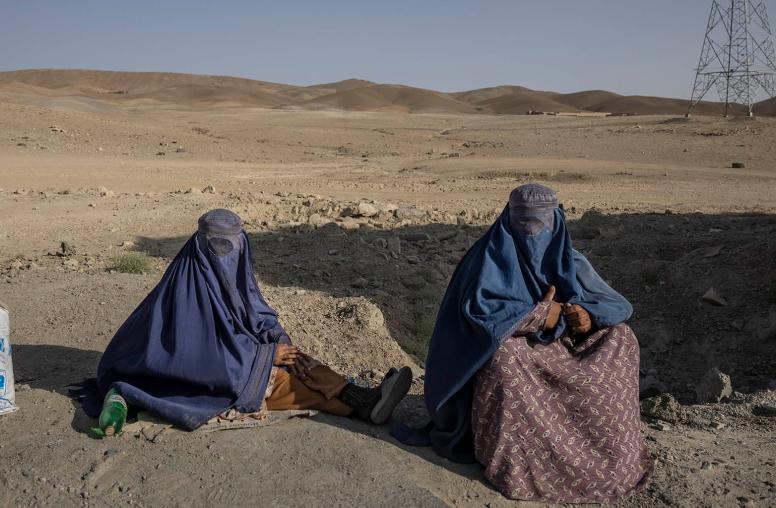Killing Friends, Making Enemies: The Impact and Avoidance of Civilian Casualties in Afghanistan
This USIPeace Briefing discusses the enormous problem of civilian casualties in Afghanistan; the “troops-in-contact” dilemma regarding air power; challenges in intelligence gathering; losses in the information war with Taliban forces; and policy recommendations to mitigate this trend.

Synopsis
This USIPeace Briefing discusses the enormous problem of civilian casualties in Afghanistan; the “troops-in-contact” dilemma regarding air power; challenges in intelligence gathering; losses in the information war with Taliban forces; and policy recommendations to mitigate this trend.
Background
The inadvertent killing of Afghans by U.S. and NATO forces undermines the international community’s efforts to stabilize Afghanistan and has resulted in a decline in approval and support for international military forces in the country. While the U.S. is in its seventh year of intervention in Afghanistan, the insurgency continues to grow. From 2002 to 2006, insurgent-initiated attacks increased by 400 percent and deaths resulting from these attacks jumped by 800 percent.1
The low number of ground troops stationed in Afghanistan, combined with an increase in insurgent attacks, has resulted in a dramatic increase in the use of air power from an average of 5,000 pounds of munitions per month in 2005 to an average of 80,000 pounds per month since June 2006, peaking at 168,000 pounds in December 2007. As a result, civilian casualties increased by 62% in 2008, compared to figures from the first six months of 2007.2 According to the Afghan government, an air strike by international forces on July 4 in Nangrahar province allegedly killed 47 civilians, including 39 women and children, although NATO has claimed that those killed in the strike were insurgents.3 This incident came just 1 day before a terrorist car bomb in Kabul killed 41 and injured 130, mostly civilians.4
Reducing civilian casualties is a moral and strategic issue. The overall effectiveness of air strikes in a counter-insurgency environment is debatable, as a large number of civilian deaths undermines battlefield successes. In order to win the confidence of the Afghan people and to counter the growing insurgency, it is critical that civilian casualties be minimized.
USIP’s Afghanistan Working Group hosted three experts to discuss this important and timely issue: Elizabeth Rubin, The New York Times; Nader Nadery, Afghanistan Independent Human Rights Commission; and Marc Garlasco, Human Rights Watch.
The Cause of Civilian Casualties
Stabilizing Afghanistan requires the support of the Afghan people. This presents a fundamental dilemma in that stability requires security, and security requires targeting insurgents, which, in turn invariably leads to civilian deaths. These civilian casualties have led to the erosion of civilian support for the counter-insurgency.
Troop levels in Afghanistan have been insufficient given the geographic and demographic scope of the challenge, resulting in increased reliance on air power as a substitute for ground forces. In early 2004, prior to the resurgence of the Taliban, the total combined International Security Assistance Force (ISAF) was 6,500 troops, with an additional 12,000 troops in the U.S.-led Operation Enduring Freedom (OEF). Overall troop levels have tripled since then, with approximately 65,000 foreign troops in Afghanistan, including 30,000 non-U.S. soldiers in the NATO-led International Security Assistance Forces (ISAF), 23,000 U.S. ISAF troops, and an additional 12,000 mostly U.S. forces under Operation Enduring Freedom command. The U.S. continues to lobby NATO allies for a greater commitment of troops and military assets for Afghanistan.
Although air strikes have somewhat successfully targeted militants, they have also significantly increased the number of innocent deaths. The correlation between the increase in insurgent attacks and air strikes parallels the relationship between utilizing aerial munitions and civilian casualties.
“Troops-in-Contact” Dilemma
NATO and the U.S. military use both preplanned and spontaneous air strikes based on combat conditions. Largely due to increased intelligence, strikes planned in advance have caused zero civilian casualties in the past two years. Collateral damage mitigation procedures range from requiring positive identification to altering the angle, depth, and type of bomb used. Approximately two-thirds of bombs currently used are low-collateral munitions. A “pattern of life” analysis—an assessment of who lives in a particular structure or area—is also required prior to calling in an air strike. The daily activities of suspected militants are tracked and analyzed to ensure that civilians are not mistakenly targeted.
The second type of air strike is a result of “troops-in-contact.” This generally occurs when a small number of troops confront militants and, after an initial exchange of fire, call in an air strike. During impromptu strikes, there is not sufficient time to complete a formal collateral damage assessment, resulting in property damage, injury, and death of innocent Afghans. In 2006 and 2007, almost every civilian casualty caused by NATO was a result of this type of incident. The increase of insurgent tactics that include firing from homes and other populated areas has significantly boosted civilian casualties. Instead of calling in troops-in-contact air strikes, soldiers are increasingly being encouraged to withdraw and disengage when confronted by overwhelming force.
The Intelligence Challenge

An Afghan boy, who allegedly got wounded by U.S. airstrikes in Waygal district of Nuristan province, lies on a bed at a hospital in Asadabad, the provincial capital of Kunar province, east of Kabul, Afghanistan, Saturday, July 5, 2008. The U.S. military said airstrikes by its attack helicopters hit two vehicles carrying insurgents Friday in eastern Afghanistan. The province's governor said 22 civilians, including a woman and a child, were killed. (AP Photo)
One of the main challenges that NATO and the U.S. military face in successfully targeting militants is incomplete or faulty intelligence. There are many instances where soldiers have to make quick decisions based on incomplete data that is difficult to verify, and even some cases where the military has been manipulated into targeting the rivals of informants. Often, if soldiers wait for confirmation of intelligence, the suspected militants have already moved. Other means of gathering intelligence can often conflict with Afghan culture. Searches of compounds and forced entry into houses are deeply offensive, especially when women and children are present. Arbitrary detentions also provoke anger and frustration.
The military needs better intelligence to avoid civilian casualties and seeks cooperation with local Afghans in order to acquire information. Civilian casualties, however, lead to a lower probability that Afghans will provide accurate information in the future. Even if intelligence is accurate, if Taliban reside in a particular locale, strikes against them are also likely to take civilian lives, further decreasing the likelihood of any future cooperation. Knowing this, the Taliban provoke air attacks and use civilians as human shields. The Taliban also threaten and kill alleged informants.
Losing the Information War
Given the remoteness of many Afghan villages and the difficulty of distinguishing between civilian victims and combatants, it is difficult for international forces and the Afghan government to release casualty figures immediately following air strikes. Even when the numbers are available, these forces frequently refuse to comment. Meanwhile, the Taliban have become increasingly effective at manipulating the media by providing inflated numbers of civilian casualties immediately following air strikes and inciting anger against international forces through exploiting such incidents in frequent propaganda campaigns.
The Way Forward
It is critical that international forces continue to develop collateral damage mitigation procedures in order to prevent civilian casualties. International forces should avoid calling in air strikes whenever possible until thorough collateral damage assessments are completed. It is also necessary for forces to conduct thorough evaluations following each air strike to evaluate the effectiveness of preventative techniques and intelligence sources.
In order to decrease the frequency of close air support strikes, long-term strategies must be developed, including an increase in the number of ground troops engaged in offensive and defensive operations to decreased reliance on air power. Such an increase in ground forces should prevent troops-in-contact incidences, which typically occur when militants outnumber NATO troops patrolling the ground. Recent announcements by the U.S., Germany, Britain, and France for planned troop increases are a step in the right direction, but these forces must also be equipped with sufficient maneuverability to get to less accessible areas.5
Collateral damage assessments require greater transparency, and investigations of alleged civilian deaths should be carried out in conjunction with the government of Afghanistan. Partnering with the Afghan government will increase the legitimacy of these evaluations and demonstrate international commitment to preventing future causalities. International forces must also become more effective at communicating openly with the media and Afghan people to counter Taliban propaganda. Therefore, results of collateral damage assessments should be published and provided to the general public in a timely manner, and families impacted by U.S. and NATO actions should be offered condolence payments, as well as reparations for property damage.
This is a critical time for NATO to reevaluate its strategy in Afghanistan. International forces face challenges, particularly the growing insurgency and mounting instability along the Afghanistan-Pakistan border. If NATO hopes to successfully counter these challenges it must retain the support of the Afghan population by preventing further injury to innocent civilians.
Notes
1. Jones, Seth G., “The Rise of Afghanistan’s Insurgency: State Failure and Jihad,” International Security 32, no. 4 (Spring 2008): 7–40.
2. Graham, Stephen, “UN Official: 62 Percent More Afghan Civilians Killed in Fighting,” Associated Press Worldstream, July 30, 2008.
3. The Washington Post, “Afghan Panel: U.S. Airstrike Killed 47 in Wedding Party,” July 12, 2008.
4. Abdul Waheed Wafa and Alan Cowell, “Suicide Car Blast Kills 41 in Afghan Capital,” The New York Times, July 8, 2008.
5. Peter Baker and Josh White, “Bush Vows to NATO: U.S. Will Add More Troops,” The Washington Post, April 5, 2008. BBC, “Extra UK Troops for Afghanistan,” June 16, 2008. Judy Dempsey and Alan Cowell, “More German Troops to Afghanistan,” The Washington Post, June 25, 2008.
This USIPeace Briefing was written by J Alexander Thier, senior rule of law advisor, and Azita Ranjbar, program assistant in the Rule of Law Center of Innovation at the United States Institute of Peace. The views expressed here are not necessarily those of USIP, which does not advocate specific policies.
The United States Institute of Peace is an independent, nonpartisan institution established and funded by Congress. Its goals are to help prevent and resolve violent international conflicts, promote post-conflict stability and development, and increase conflict management capacity, tools, and intellectual capital worldwide. The Institute does this by empowering others with knowledge, skills, and resources, as well as by directly engaging in peacebuilding efforts around the globe.




